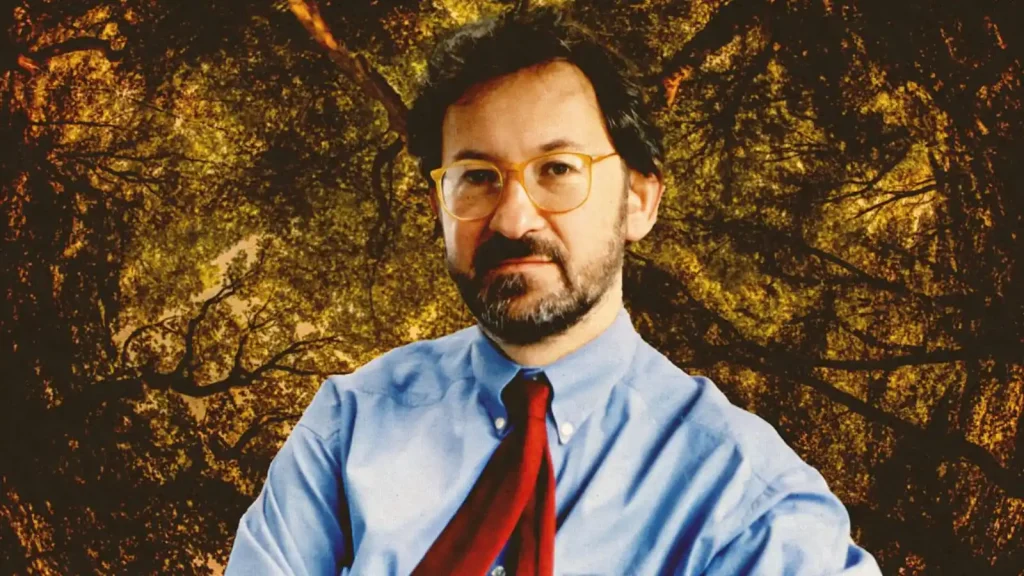Landscape and Memory episode 1: Historian Simon Schama’s groundbreaking series Landscape and Memory begins with an exploration of one of the most enigmatic and essential elements of our planet: forests. In the opening episode, Schama delves into the profound relationship between humans and forests, intertwining culture and nature to reveal the rich tapestry of myth, memory, fear, and reverence that has surrounded these ancient woodlands for centuries.
Forests are far more than just collections of trees. They have been sacred spaces, places of solitude, refuge, and inspiration. Across time and civilizations, they have symbolized both the unknown and the sublime. In many cultures, forests hold the power to invoke awe, fear, and even terror—places where mythological creatures lurk in the shadows, where spirits of the earth dwell among the trees, and where humans face the untamed forces of nature head-on. This is the story Simon Schama begins to unravel in Landscape and Memory, painting a picture of forests not just as physical landscapes but as cultural ones, deeply rooted in our collective consciousness.
Schama begins his exploration by looking at the mythology surrounding forests. From ancient sacred groves to modern conservation efforts, forests have long been considered places of deep significance. They have appeared as sites of worship in countless cultures, places where the divine seems just a little closer. For example, sacred groves were once common across Europe, particularly in Germany and Scandinavia, where ancient peoples believed that gods and spirits lived among the towering trees. Forests, in these stories, weren’t just environments—they were sentient, powerful forces to be respected and even feared.
This reverence for the forest isn’t limited to ancient mythology. Even in modern times, forests hold a symbolic power. They stand as emblems of endurance, survival, and nature’s resilience in the face of human encroachment. But they are also places of memory, where the past lingers in the rustle of leaves and the creak of ancient trunks. As Schama points out, forests have witnessed the passage of time and the shifts in human history. From the legends of Robin Hood hiding in Sherwood Forest to the ancient forests that once covered much of Germany, these wooded spaces have long been tied to both history and folklore.
Forests have also been places of fear, often seen as the antithesis of civilization. In European folklore, they are often depicted as dark, dangerous places—homes to wolves, witches, and other creatures that threaten human society. Even today, forests can inspire a primal sense of dread, reminding us of our vulnerability in the face of nature’s raw power. In this sense, the forest becomes a mirror of our own fears, a place where the boundaries between reality and myth blur, and where the unknown lurks just beyond the next tree.
But alongside this fear is also a deep sense of connection. The natural environment of forests has always played a vital role in shaping human culture. They provide us with materials for building, fuel for warmth, and spaces for reflection and retreat. And as Schama explores, forests have also become symbols in the fight for environmental conservation. With deforestation threatening these ancient spaces, the modern world has recognized the need to preserve what remains of our forests—not just for their ecological importance but for their cultural and historical value as well.
Schama’s work doesn’t just stop at the stories of ancient forests or folklore. He also examines the very real, ongoing battle for the future of forests today. As we confront global environmental challenges, from climate change to deforestation, the forest stands as a symbol of both what we have to lose and what we might yet save. Urban forestry and forest management have become critical topics, and Schama brings these contemporary issues into sharp focus, showing how our relationship with the forest continues to evolve.
Landscape and Memory episode 1 – Forests
In particular, he highlights the role forests play in historical ecology, a field that studies the interactions between human societies and their environments over time. By looking at the forests of the past, Schama helps us understand the deep connections between people and nature, and how these connections have shaped both our cultures and our landscapes. From the ancient forests of Germany to the heavily logged forests of the United States, every tree has a story, and every forest a history.
Schama’s Landscape and Memory is not just a historical investigation but a meditation on the deep, often unseen ties between culture and nature. His work reminds us that forests are more than just backdrops to human history—they are active participants in it. As he takes us through the myths and memories embedded in these wooded landscapes, he reveals how forests have shaped our fears, our beliefs, and our very sense of identity.
Through Schama’s lens, forests become living, breathing entities—repositories of memory, places of worship, and symbols of nature’s enduring power. As we walk through their shaded paths, we are reminded that these spaces are not only part of the natural world but also integral to the story of humanity itself. And in the face of increasing environmental pressures, Schama’s exploration of forests asks us to consider not just the landscape before us but the one we hope to leave behind.
Conclusion Landscape and Memory episode 1 – Forests
In conclusion, Simon Schama’s exploration of forests in Landscape and Memory goes far beyond a simple historical narrative. Through the lens of myth, memory, and nature, he reminds us that forests are deeply intertwined with our past and present. They are living chronicles, holding the stories of our ancestors, while also reflecting our ongoing relationship with the natural world.
Forests, as Schama illustrates, are places where the lines between the human and the natural blur. They’ve long stood as symbols of both sanctuary and danger—spaces where we confront our deepest fears and find profound spiritual connection. Their roots dig deep into the earth, but they also reach into our collective consciousness, shaping how we understand the world around us.
Today, as we face environmental challenges like deforestation and climate change, Schama’s work feels more relevant than ever. The forests that inspired fear and reverence in ancient times are now in peril, reminding us of what is at stake. Yet, within this threat lies hope—forests remain symbols of resilience, capable of rebirth if we choose to protect them.
Schama invites us to not only remember the past but to imagine a future where forests continue to be sacred spaces, teeming with life and meaning. He urges us to reconsider how we view the landscape, not as something separate from us, but as an integral part of our identity and survival. As we move forward, the question remains: will we embrace the lessons the forests offer, or let them fade into memory? The choice, as Schama implies, is ours to make.
FAQ Landscape and Memory episode 1 – Forests
Q: What is the central theme of Simon Schama’s Landscape and Memory episode 1?
A: In the first episode of Landscape and Memory, Simon Schama embarks on a journey to explore the intricate relationship between humans and forests. He delves into how forests have shaped our cultures, beliefs, and fears throughout history, demonstrating that these woodlands are far more than just collections of trees. Instead, they are deeply intertwined with our collective consciousness, serving as repositories of memory, places of worship, and powerful symbols of nature’s enduring presence.
Q: How does Schama portray forests in this episode?
A: Schama masterfully portrays forests as living, breathing entities that have played a pivotal role in human history. He illustrates how forests have served as sources of inspiration, fear, and reverence across different cultures and time periods. Furthermore, he emphasizes their significance as cultural landscapes, deeply embedded in our myths, folklore, and historical narratives.
Q: What specific examples does Schama use to illustrate the cultural significance of forests?
A: To illustrate the profound impact of forests on human culture, Schama draws on a rich tapestry of examples. He discusses the ancient sacred groves of Germany and Scandinavia, where people believed gods resided amongst the trees. Additionally, he explores the legends of Robin Hood, highlighting how Sherwood Forest became a symbol of resistance and social justice. By weaving together these diverse narratives, Schama illuminates the multifaceted ways in which forests have shaped our understanding of the world.
Q: How does the episode address the modern environmental challenges facing forests?
A: While steeped in history and mythology, the episode also confronts the contemporary environmental threats to forests. Schama acknowledges the urgent need for conservation efforts in the face of deforestation and climate change. He stresses the importance of sustainable practices, such as urban forestry and forest management, to ensure that future generations can continue to benefit from these vital ecosystems.
Q: What is the significance of historical ecology in understanding our relationship with forests?
A: Schama emphasizes the crucial role of historical ecology in comprehending the complex interplay between humans and their environment. By examining the historical interactions between societies and forests, we can gain valuable insights into how our actions have shaped both the landscape and our own cultures. This understanding is essential for developing sustainable practices and ensuring the preservation of forests for future generations.
Q: How does the episode explore the duality of fear and connection associated with forests?
A: Schama skillfully captures the contrasting emotions that forests evoke. He acknowledges the primal fear that forests can inspire, often depicted in folklore as dark and dangerous places inhabited by mythical creatures. However, he also emphasizes the deep sense of connection that humans feel towards these natural spaces. Forests offer solace, resources, and a profound sense of belonging, demonstrating the complex and multifaceted nature of our relationship with them.
Q: What is the overall message that Schama conveys about forests in this episode?
A: Ultimately, Schama’s exploration of forests serves as a powerful reminder of their enduring importance in human history and culture. He urges us to recognize their value not just as ecological resources, but also as sources of inspiration, memory, and spiritual connection. By understanding our past relationship with forests, we can better appreciate their significance in the present and make informed choices to safeguard their future.
Q: How does the episode encourage viewers to engage with the topic of forest conservation?
A: Through his compelling narrative, Schama inspires viewers to become active participants in the conservation of our planet’s forests. He highlights the urgent need to protect these vital ecosystems from the threats of deforestation and climate change. Moreover, he encourages viewers to reflect on their own relationship with nature and consider how they can contribute to a more sustainable future for forests worldwide.





We tried to watch this last night. Exactly every 3 minutes a 15 second ad was shown. It made viewing impossible. Just as one was settling in to concentrate on what Simon Shama was saying, another ad would cut in often in the middle of a sentence. After the ad, it took another coupld of minutes to pick up the thread of the conversation at which point another ad would be due. We gave up. Nobody minds the odd ad but every 3 minutes! If this continues, we won’t be using your website anymore.